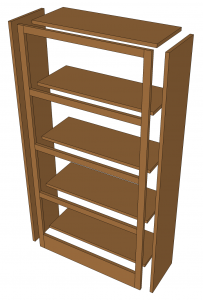We may receive a commission when you use our affiliate links. However, this does not impact our recommendations.
In our live webinar on February 18, artist and furniture designer Yoav Liberman will talk about getting design inspiration from raw materials. Here’s something that frequently inspires my furniture designs: I don’t have enough tools. Fortunately, you don’t have to have every tool in the catalog to design and build your own furniture. If you have a good saw and a nail or screw gun, you can make a lot of different projects with a little creativity.
Use Plywood in Your Furniture Design
Plywood is an excellent material for a variety of projects. It’s flat and doesn’t move much with changes in humidity. You can buy pre-glued edge banding that applies with a hot iron to cover up those raw edges. Think about this material whenever you’re designing built-ins or cabinets.
Or Veneer
Instead of gluing up thick table legs with solid wood, cut four pieces of MDF and nail or screw them together. Then fill the screw holes, sand the filler flush with the MDF, and apply veneer to all four faces. You can use paper or phenolic-backed veneer and bond it to the MDF with contact cement. Or, you can use yellow glue and a clothing iron. Veneered legs often look better than solid wood legs because you can get the same kind of grain on all four faces.
Buy Your Lumber S4S
The lumber you buy at the home center is usually called S4S, which means that it has been surfaced or planed on all four sides. Home centers have a limited variety of species, but your local hardwood supplier will probably plane lumber for a small fee, sometimes as little as $.15/foot.

Plywood is great for case parts, and S4S lumber makes good face frame material that can be pocket-screwed together for hidden joinery.
Get a Pocket-Hole Jig
Cabinet shops use pocket-hole joints for a surprising number of projects. Face frames are almost always built with pocket holes. Casework can be put together this way, too. You can design all sorts of projects when you have one of these jigs in your shop, and the least expensive model is about $10.
As you acquire more tools, you can design more elaborate projects. In the meantime, you can create some excellent projects by designing for the tools you have.
Check out Yoav Liberman’s February 18 webinar, Urban Woodworking: Designing One-of-a-Kind Furniture for an in-depth look at the process of creating unique pieces.
Here are some supplies and tools we find essential in our everyday work around the shop. We may receive a commission from sales referred by our links; however, we have carefully selected these products for their usefulness and quality.










MDF has a problem: it’s not water resistant. Expose it to any small amount of water and it immediately swells. Even worse, if that contact is prolonged for even just a few hours, you’ll likely get a nice mold colony growing in it. It’s not a material I would recommend if you’re looking for a result that will last a long time, in my opinion. It may be better to start with quality plywood instead.
S4S lumber at the home center is very expensive. I found it was better to buy S2S material and joint one edge with either a table saw (straight edge attached to one edge) or a router table. Failing those options a nice used jointer plane should cost less than $100 most of the time and would quickly pay for itself.
Even so, most of the S4S stuff that I see isn’t flat and square even though it was flat and square when it was cut. Wood changes over time, so even the pre-cut and milled S4S material may not be better than S2S.